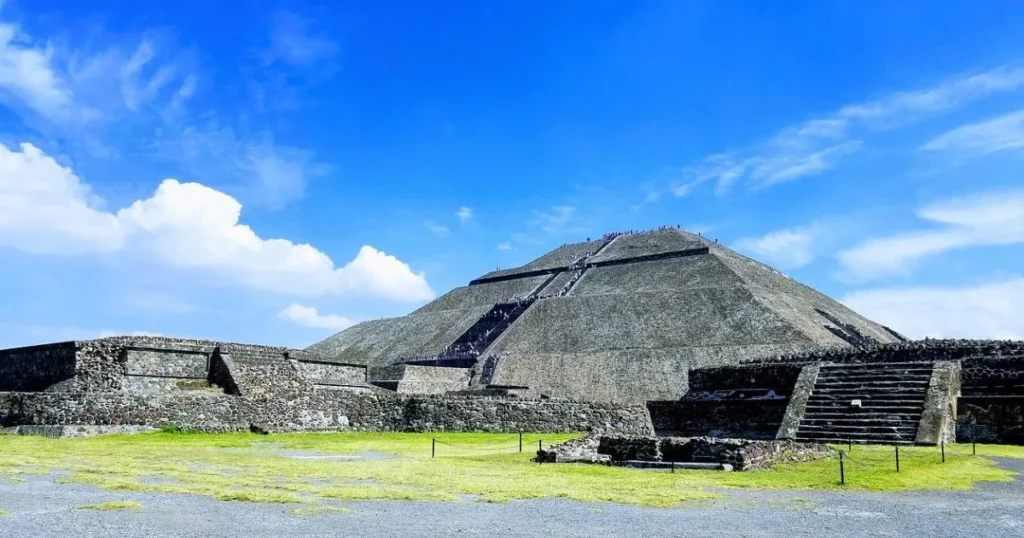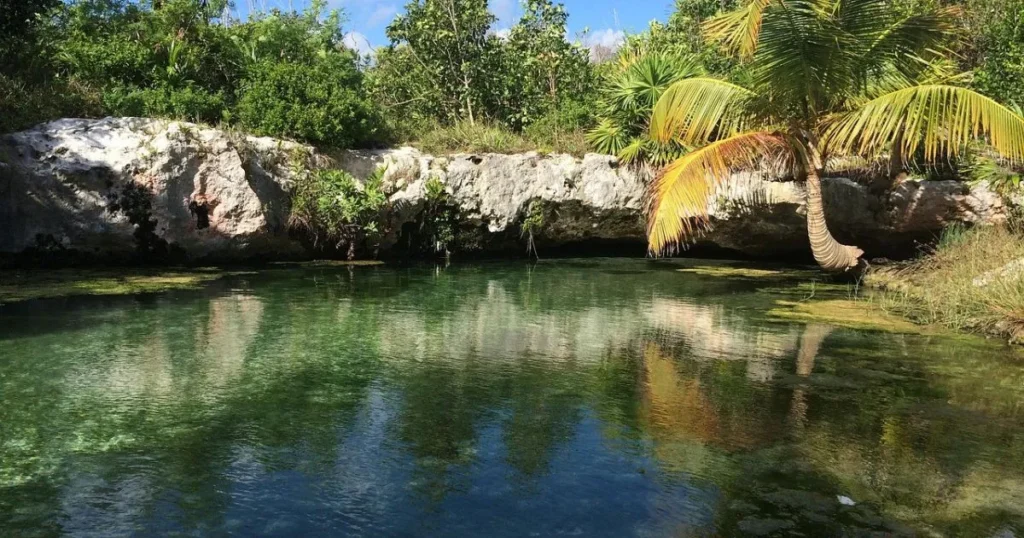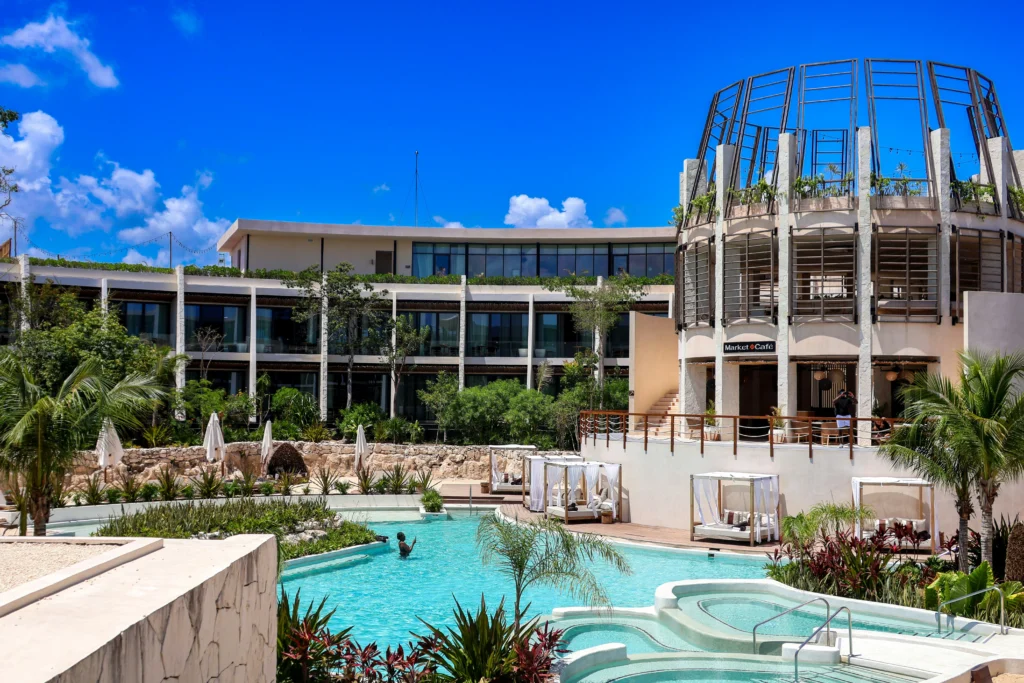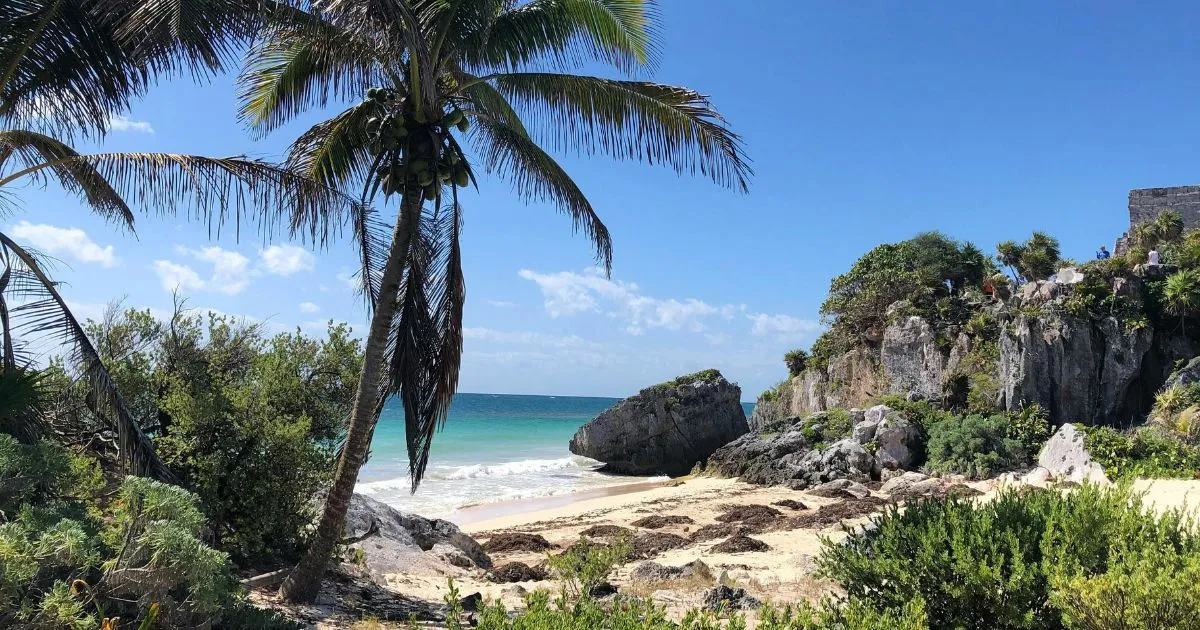Where Is Tulum? 5 Powerful Reasons to Visit Mexico’s Stunning Boho Beach Town
The Caribbean whispered my name long before I set foot in Tulum. As a travel enthusiast, I sought a break from common tourist spots. Tulum blends the mystery of ancient Mayan heritage with a trendy, bohemian vibe, creating a truly enchanting destination. It’s not just another beach town – it’s a place that captures your heart with its stunning Caribbean coastline and deep cultural depth.
Nestled in the Quintana Roo state of Mexico’s Yucatan Peninsula, Tulum offers a unique mix of natural beauty and historical significance. Your Tulum travel guide starts here. It shows a place about 80 miles south of Cancun Airport, right along the stunning Riviera Maya region.
Tulum blends pristine shores with ancient landmarks, creating the perfect balance of relaxation and exploration. Whether you’re drawn to history, sun-soaked shores, or cultural explorations, Tulum promises memories that last a lifetime. Tulum delivers more than just a getaway—it’s a transformative experience.
Table of Contents
Geographic Location and Overview
Situated in the vibrant Riviera Maya on Mexico’s Yucatán Peninsula, Tulum lies at the crossroads of nature and history. Tulum brings together lush nature, deep historical roots, and a tropical ambiance. Knowing where Tulum is in Mexico helps you see its special location.
Located along the Caribbean coastline, Tulum is both accessible and serene. The area has amazing beaches, green jungles, and ancient ruins all together.
Distance from Major Cities
Getting to Tulum means traveling through important places in Mexico. Here’s a quick guide for you:
- Cancun: About 120 kilometers (75 miles) north
- Playa del Carmen: Around 65 kilometers (40 miles) north
- Cozumel: Roughly 90 kilometers (56 miles) northeast
Riviera Maya Region Context
The Riviera Maya, a stunning coastal stretch along the eastern Yucatán Peninsula, is home to Tulum’s charm. It’s known for its blue waters and green landscapes. Tulum is a highlight here, with its ancient ruins and natural beauty.
| Region Characteristic | Tulum’s Specific Feature |
|---|---|
| Coastline Length | 9 kilometers of pristine Caribbean beaches |
| Ecological Zones | Tropical forest, coastal ecosystems, archaeological zones |
| Cultural Significance | Ancient Mayan archaeological site and modern bohemian destination |
Quintana Roo State Overview
Tulum is in Quintana Roo, where nature meets modern travel. The state has some of Mexico’s most stunning coastlines. This mix makes Tulum a favorite for those craving both adventure and relaxation.
Getting to Tulum: Transportation Options
Planning your trip to Tulum means knowing your travel options. Your journey starts with picking the best airport and how to get there.
- Tulum International Airport (Felipe Carrillo Puerto Airport)
- Cancun International Airport
With the recent launch of Tulum International Airport, travelers can now reach the region directly from major cities. If you land in Cancun, you’ll find many ways to get to Tulum.
| Transportation Method | Estimated Travel Time | Approximate Cost |
|---|---|---|
| Private Shuttle | 1.5-2 hours | $60-$120 |
| Shared Van | 2-2.5 hours | $20-$40 |
| Public Bus | 2.5-3 hours | $10-$15 |
The soon-to-launch Mayan Train offers a contemporary way to experience the area’s rich heritage and natural beauty. It connects Cancun to Tulum, offering a scenic and comfy ride through the Riviera Maya.
“Tulum isn’t just a place—it’s a journey of discovery.” – Local Travel Expert
Think about your budget, comfort, and how long you want to travel when choosing your transport. Each choice has its own perks for your Tulum adventure.
1.Where is Tulum’s Beach Zone Located?
Tulum beaches are a stunning tropical paradise. They are divided into distinct zones for different experiences. The coastline stretches along two main areas: the Hotel Zone and the National Park. Each offers breathtaking views and unique beach characteristics.
Exploring Tulum’s beaches reveals a diverse coastal landscape. You’ll find everything from pristine white sands to crystal-clear turquoise waters. These beaches are among Mexico’s most beautiful shorelines.
North Beach Area
The North Beach area includes Playa Ruinas and Playa Paraiso. It offers spectacular scenery. Playa Ruinas is famous for its close proximity to ancient Mayan ruins. It combines historical exploration with beach relaxation.
- Stunning views of Mayan ruins
- Soft white sand beaches
- Excellent snorkeling opportunities
South Beach Area
Tulum’s South Beach zone has a more developed and bohemian vibe. It’s home to eco-friendly resorts, beach clubs, and a lively scene. This area attracts international travelers looking for a refined beach experience.
Beach Access Points
Getting to Tulum beaches is easy. You can access most beaches through:
- Public beach entrances
- Hotel and resort pathways
- Dedicated beach clubs
“Tulum’s shores offer more than scenic views—they immerse you in nature’s untamed elegance.” – Local Travel Guide
Whether you want tranquility or adventure, Tulum beaches have it all. Its varied shoreline guarantees breathtaking experiences framed by stunning natural beauty.
2.Tulum’s Main Districts and Areas

Tulum is a special place with different areas, each with its own vibe. It’s divided into three main zones: the beach, downtown (Tulum Pueblo), and new residential spots.
Each district in Tulum offers its own unique vibe and activities for visitors to enjoy. The beach zone is where you’ll find most of the tulum hotels and all-inclusive resorts. It’s known for its stunning beaches and views of the Caribbean Sea.
- Beach Zone: Luxury accommodations and pristine shorelines
- Downtown (Pueblo): Authentic Mexican atmosphere
- Residential Areas: Aldea Zama and La Veleta
Tulum Pueblo gives you a taste of true Mexico. It’s home to affordable hotels and local eateries. The downtown area is connected to the beach by a 3km road called Avenida Coba.
Aldea Zama and La Veleta showcase the modern growth and aesthetic appeal of Tulum’s evolving landscape. They’re popular with digital nomads and investors for their modern features and green design. Some resorts are now opening in these spots, mixing comfort with eco-friendliness.
Each district in Tulum provides a unique perspective on this magical destination.
3.The Ancient Mayan Connection
Tulum offers a vivid glimpse into the depths of ancient Mayan culture. It shows the ancient architectural and cultural brilliance of the Mayans. Perched on a cliffside, the ruins gaze out over the brilliant blue of the Caribbean Sea.
The site showcases the Mayans’ urban planning and defense skills. Visitors can explore key structures. These reveal insights into the Mayans’ complex social and religious practices.
Historical Significance
Tulum was a key trading and religious center in the late Postclassic period. The ruins show the community’s importance through its strategic location and impressive design.
- Once operated as a key maritime hub supporting the ancient city of Coba
- Remained occupied into the early Spanish colonial period
- Functioned as an important astronomical and trade hub
Archaeological Zone Location
The ruins sit on a 39-foot cliff. This position gave the Mayans defensive advantages and stunning ocean views. It allowed them to monitor maritime trade routes and protect their settlement.
Preservation Areas
Conservation efforts protect the site for future generations. UNESCO has recognized the tulum ruins as a World Heritage Site. This highlights their global cultural significance.
“Tulum represents a perfect intersection of natural beauty and historical magnificence.” – Archaeological Research Institute
Exploring these ancient ruins is a journey through Mayan history. Travelers can explore centuries-old structures that remain as powerful echoes of the past. They tell stories of a sophisticated and advanced civilization.
4.Natural Surroundings and Eco-Systems

Tulum is more than just beaches. It’s a nature lover’s dream with incredible ecosystems.Central to the region is the Sian Ka’an Biosphere Reserve—a UNESCO-protected ecological wonder. It spans over 780,000 acres of untouched wilderness.
Exploring Tulum reveals stunning ecosystems. The region features lush mangroves, crystal-clear lagoons, and vibrant coral reef ecosystems. These places are perfect for eco-tourism and spotting wildlife.
- Explore lush tropical jungles
- Observe diverse marine and terrestrial wildlife
- Discover hidden cenotes
- Experience sustainable ecological tours
The area’s geology is also fascinating. Cenotes, natural sinkholes, are a must-see for thrill-seekers. These water holes were vital to the Mayans and still amaze today with their beauty.
| Ecosystem Type | Key Features | Wildlife Highlights |
|---|---|---|
| Mangrove Forests | Complex root systems | Manatees, Crocodiles |
| Coral Reefs | Vibrant underwater landscapes | Tropical Fish, Sea Turtles |
| Tropical Jungle | Dense vegetation | Howler Monkeys, Exotic Birds |
Whether you love wildlife, nature, or adventure, Tulum has it all. It offers a unique chance to connect with the area’s amazing biodiversity.
Climate and Best Time to Visit
Understanding Tulum’s climate is essential to planning the perfect vacation. It has a tropical climate that draws visitors all year. Every season offers unique highlights that can shape your travel experience.
Understanding seasonal weather trends is key to planning the perfect visit to Tulum. The area has three main seasons for visitors:
- High Season (December – April): Perfect weather and lots of tourists
- Mid-Season (May – July): Warm and sometimes rainy
- Low Season (October – November): Fewer people and lower prices
Seasonal Weather Patterns
Tulum’s weather is usually warm, between 75°F and 90°F all year. The dry season is sunny and dry, attracting most visitors. Summer is more humid with some rain.
Peak vs Off-Peak Seasons
In the high season, you can expect:
- Higher hotel prices
- Crowded spots
- Great beach weather
Seaweed Season Considerations
May to October, Tulum’s beaches might have sargassum seaweed. But, many resorts work hard to keep beaches clean. This helps your trip stay enjoyable.
Local Infrastructure and Development

Tulum is changing fast, becoming a top spot for travelers. The town is growing its infrastructure to handle more tourists. It’s doing this while keeping its natural beauty intact.
Getting around Tulum is getting better. The main road, Highway 307, is now easier to use. It helps visitors enjoy this beautiful Mexican place.
- Road conditions have improved significantly in the past five years
- Public transportation now includes more frequent bus routes
- Bike lanes are being expanded to support eco-friendly travel
Tulum is all about being green. The town is working hard to use water and waste wisely. This is important because of its sensitive environment.
| Infrastructure Aspect | Current Status | Development Focus |
|---|---|---|
| Water Management | Improving | Sustainable Water Systems |
| Waste Disposal | Modernizing | Eco-Friendly Waste Solutions |
| Transportation | Expanding | Green Transit Options |
Your Tulum travel guide shows how the town balances growth and preservation. It’s a careful dance to keep its natural and cultural treasures safe.
Visitors can expect better infrastructure that supports tourism and nature. Tulum’s future looks bright and exciting for all who visit.
5.Neighboring Attractions and Day Trips
Tulum’s charm extends far beyond its stunning coastlines and archaeological sites. The area around it is full of natural wonders and historical sites. These places will make your trip an adventure you’ll never forget.
Exploring Magical Cenotes
Cenotes are underground pools filled with water. They offer amazing swimming and diving spots. Near Tulum, you can find several incredible cenotes.
- Gran Cenote boasts crystal-clear waters, ideal for a refreshing swim
- Dos Ojos is a favorite spot for snorkeling and diving lovers thanks to its captivating underwater views
- Cenote Calavera: Known for dramatic rock formations
Sian Ka’an Biosphere Reserve
Sian Ka’an, honored as a UNESCO World Heritage Site, is a top destination for nature lovers. It’s known for its eco-tours that show off the area’s wildlife. No trip to Tulum is complete without experiencing this incredible reserve.
Nearby Archaeological Sites
History lovers will enjoy the ancient Mayan ruins near Tulum. Here are some sites worth visiting:
| Site | Distance from Tulum | Highlights |
|---|---|---|
| Chichen Itza | 2.5 hours | World-famous pyramid and UNESCO site |
| Coba | 45 minutes | Largest network of stone causeways |
| Muyil | 20 minutes | Less crowded, authentic Mayan experience |
These sites give a glimpse into the Yucatan Peninsula’s rich history. They are must-see places for anyone interested in history and culture.
Where is Tulum Growing? Future Development Plans
Tulum is changing fast, moving from a quiet beach town to a global attraction. Tulum’s hospitality scene is poised for major transformation, with new resorts and upgrades on the horizon.
Plans aim to grow smartly, keeping Tulum’s natural beauty intact. Key areas include:
- Sustainable urban infrastructure
- Eco-friendly tulum hotels
- Enhanced transportation networks
- Controlled tourism development
Investors want to create new, green hotels. Tulum all-inclusive resorts will grow, focusing on saving the environment and offering real local experiences.
| Development Focus | Projected Impact |
|---|---|
| Eco-Tourism Infrastructure | Reduce environmental footprint |
| Luxury Sustainable Resorts | Attract high-end environmentally conscious travelers |
| Community Integration | Preserve local cultural authenticity |
Your next trip to Tulum will mix modern comforts with untouched nature. The area’s growth will honor its natural and cultural treasures.
Conclusion
Your Tulum travel guide shows this boho beach town is special. Tulum seamlessly blends scenic landscapes, historical depth, and a lively cultural scene. From scenic coastlines to historic Mayan sites, Tulum offers a rich and varied experience.
The nightlife in Tulum is also a big draw. You can choose from laid-back beach clubs to lively disco scenes. Whether you’re into adventure, culture, or relaxation, Tulum caters to every kind of traveler.
Visiting Tulum means making memories you’ll never forget. It’s where the wonders of nature, the depth of history, and visual beauty unite seamlessly. Prepare yourself for an unforgettable journey in this jewel of the Mexican Caribbean.
Are you ready to see Tulum’s magic? Start planning your trip. Discover why so many travelers love this place. Tulum welcomes you with its stunning nature, rich traditions, and laid-back atmosphere.
FAQ
What is the exact location of Tulum?
How can you get from Cancun International Airport to Tulum?
Which neighborhoods in Tulum are best for accommodations?
When is the perfect time of year to visit Tulum for the best experience?
What makes Tulum’s beaches unique?
Are there any ecological concerns in Tulum?
What archaeological sites can I visit near Tulum?
What are cenotes, and where can I find them?
How is Tulum’s infrastructure developing?
What activities can I do in Tulum?
Share Your Opinion & Experience
💬 Have you tried this idea or do you have better tips? Share them with us so other travelers can benefit.
There are no reviews yet. Be the first one to write one.

